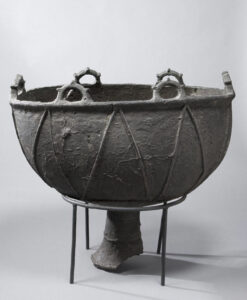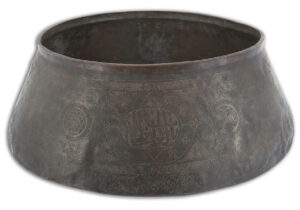Editor’s note: Discover Kazakhstan is a column dedicated to exploring the rich cultural heritage and natural wonders of the country. Each article explores various aspects of Kazakh life and history, offering insights and stories that highlight their unique significance.
An ancient Saka cauldron’s journey through the time
In 1993 a resident of Mukhammadi village in the Payarik district in the Samarkand Region of Uzbekistan, Anvar Shagdarov, unearthed an old kazan (cauldron) whilst digging a canal. This cauldron then faithfully served his family for three decades. Fortunately, this region is known not only for the Registan Square, the Gur-e-Amir Mausoleum, or silk carpets but also for its Samarkand pilaf, which is cooked over an open fire and only in a kazan. It would have likely continued to serve his family, passing down from generation to generation, if not for the interest of representatives from the Agency for Cultural Heritage of Uzbekistan last year. In this very cauldron belonging to the former director of the village school, they saw traces of a bronze Saka cauldron, which according to expert analysis dates back to the 2nd-1st century BCE. Rome had not yet become an empire, and The Han–Xiongnu Wars were just gaining momentum, but this cauldron from the village in the Samarkand region already existed. As a result, this valuable item has successfully moved from the family kitchen into the State Museum of Culture History of Uzbekistan collection.

Cauldron. Mound of Solokha. 5th century BC / State Hermitage Museum. Saint-Petersburg.
From an outside perspective, this incident might seem quite comical, but not in a country where cooking in a kazan is a common routine that any self-respecting person prepares for from a conscious youth, especially in rural areas. Astonishingly, the real age of the kazan hasn’t affected the taste qualities of Samarkand pilaf. And yet, it spent centuries buried underground.
The Turkic word ‘kazan’ (or ‘kazgan’ in a more archaic form) exists in almost all Turkic languages and has been borrowed by other nations, including Russia. Kazan literally means ‘to dig’ or ‘to scrape.’ In the case of Turkic languages, there is often no clear distinction between ‘kazan’ and ‘pot,’ so any solid spherical/semi-spherical metal dish for cooking food over a fire can be broadly referred to as a kazan, and explaining their difference is often impossible.
Nevertheless, throughout millennia, the cauldron has possibly been the most essential and irreplaceable item of utensils worldwide, both for nomadic peoples and settled populations alike. At the very least, to this day, in our region, it has not lost its utility. It is no wonder that in archaeological excavations across the entire territory of Central Asia—from the Iranian plateau to Southern Siberia—cast pots and cauldrons of different eras and cultures, made from copper, bronze, iron, and cast iron, are encountered. But despite this, the most sought-after in archaeological circles, and therefore the most famous among them, have always been the Saka (Scythian) kazans, in which these Eurasian nomads prepared meat and dairy products. Primarily, these bronze cauldrons, abundant in Saka burial mounds from the Pamirs to the Altai Mountains, are attractive for their unique ornamentation and intricate Scythian animal style, depicting both real animals and mythical creatures.

Sacred Cauldron. Photo credit: Ottoman archive
Scholars believe that beyond their utilitarian purpose, Saka cauldrons always possessed a sacred character, which explains the exquisite depictions of sacred and ritual animals on them. Therefore, they were cherished, cleaned, and repaired. The sanctity and symbolism of Saka bronze cauldrons were first sung by the Father of History, Herodotus. He recounted the cauldron belonging to the Scythian king Ariantas, six fingers in thickness, capable of holding 600 amphoras (almost twenty thousand liters). According to Herodotus, Ariantas wanted to ascertain the number of Scythians and, under the threat of death, ordered each person to bring an arrowhead. From these arrowheads, he subsequently fashioned this immense cauldron of Scythian solidarity and power. It is no wonder that within the more humble and narrow circles such as a tribe or family, the cauldron became a central unifying object, which to some extent has persisted to this day.
The sanctity of the cauldron did not fade even with the arrival of Islam in Central Asia; on the contrary, it was a cult object in Sufi retreats (tekkes or khanqah). After all, these retreats or Sufi houses were inconceivable without a cauldron. Undoubtedly, the central ritual item of The Mausoleum of Khoja Ahmed Yasawi in Turkistan is precisely the ‘Taiqazan’ (Kazakh: ‘taikazan,’ ‘cauldron the size of a stallion’) — a two-ton cauldron with a capacity of 3000 liters, adorned with verses from the Quran, which was gifted to the sanctuary by Amir Timur himself in 1399. In 1935, it was taken to the Hermitage, which the people considered a sacrilege, and after many efforts, it was only able to be returned to its rightful place in 1989.
Meanwhile, it is unknown how the State Museum of History of Culture in Samarkand compensated for the inconvenience to the resident of the village of Mukhammadi who found that bronze Saka kazan. But we hope that his family continues to gather around a new kazan and enjoy the taste of their Samarkand pilaf. After all, there is a reason why a person’s stomach is called ‘asqazan’ in Kazakh, which translates to ‘cauldron for food.’
Based on an original article by Zhar Zardykhan, Kazakh historian, Qalam’s Editor-in-Chief. The full article can be found on the Qalam project website.


